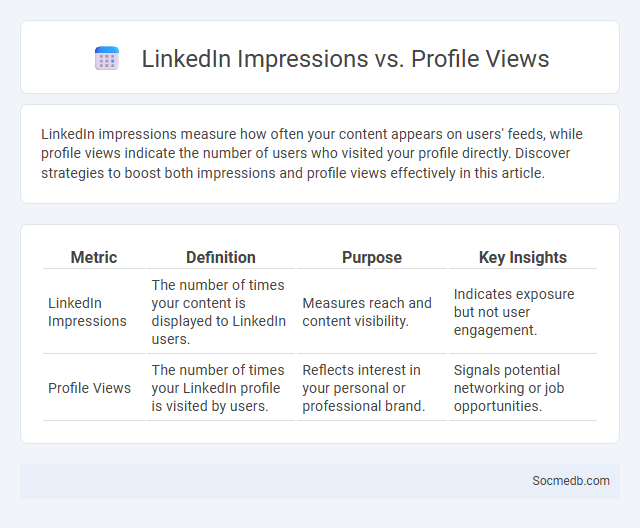
Photo illustration: LinkedIn Impressions vs Profile Views
LinkedIn impressions measure how often your content appears on users' feeds, while profile views indicate the number of users who visited your profile directly. Discover strategies to boost both impressions and profile views effectively in this article.
Table of Comparison
| Metric | Definition | Purpose | Key Insights |
|---|---|---|---|
| LinkedIn Impressions | The number of times your content is displayed to LinkedIn users. | Measures reach and content visibility. | Indicates exposure but not user engagement. |
| Profile Views | The number of times your LinkedIn profile is visited by users. | Reflects interest in your personal or professional brand. | Signals potential networking or job opportunities. |
Understanding LinkedIn Impressions: What Does It Mean?
LinkedIn impressions represent the number of times your content, such as posts or articles, appears on users' screens, indicating potential visibility rather than direct engagement. Tracking impressions helps marketers and professionals measure brand awareness and content reach within their target audience on LinkedIn. High impression counts paired with strong engagement rates often signal effective content strategies and increased network influence on the platform.
Defining Profile Views on LinkedIn
Profile views on LinkedIn indicate the number of times other users have visited your professional profile, providing insight into your visibility and networking reach. This metric helps gauge how effectively your LinkedIn presence attracts recruiters, potential employers, and industry peers. Monitoring profile views enables strategic adjustments to your content and connections to maximize professional engagement and career opportunities.
LinkedIn Impression vs Profile View: The Key Differences
LinkedIn impressions represent the number of times your content appears on users' feeds, while profile views indicate how many users have actively visited your LinkedIn profile. Impressions measure content visibility and brand awareness, whereas profile views reflect direct interest in your professional background and expertise. Understanding these metrics helps you optimize your LinkedIn strategy to boost both exposure and meaningful engagement with your target audience.
How LinkedIn Measures an “Impression”
LinkedIn measures an impression when a post or advertisement appears on a user's feed, regardless of engagement or clicks. This metric tracks the total number of times content is visually rendered on screen, helping marketers gauge reach and visibility. Impressions do not indicate user interaction but provide insight into potential audience exposure.
Why Profile Views Matter for Personal Branding
Profile views on social media platforms serve as a key indicator of personal brand visibility and audience engagement, reflecting how often individuals or professionals attract attention within their niche. High profile view counts enhance credibility and open up opportunities for networking, collaborations, and career advancements by signaling active interest to potential employers or partners. Monitoring and optimizing profile views through consistent content updates and targeted interactions can significantly strengthen personal brand recognition and influence.
Tracking Impressions vs Profile Views: Analytics Tools
Tracking impressions measures the total number of times your content appears on users' screens, providing insight into overall reach and brand visibility on platforms like Instagram and Facebook. Profile views indicate the number of users who actively visit your social media profile, reflecting deeper interest and engagement with your personal or business brand. Understanding the difference between these metrics helps you optimize your content strategy using analytics tools such as Google Analytics, Sprout Social, or Hootsuite to boost Your social presence effectively.
Factors Influencing Impressions on LinkedIn Content
Understanding factors influencing impressions on LinkedIn content is crucial for maximizing your reach and engagement. Key elements include posting time, content relevance, use of relevant hashtags, and audience interaction such as comments and shares. Optimizing your profile and consistently sharing valuable insights tailored to your professional network significantly boosts the visibility of your posts.
Strategies to Increase Profile Views and Impressions
Optimizing social media profiles with relevant keywords and engaging visuals significantly boosts profile views and impressions. Consistent posting of high-quality, shareable content aligns with platform algorithms to enhance visibility and audience reach. Leveraging hashtags, tagging influencers, and engaging with followers through comments and stories further amplify profile exposure and interaction rates.
Interpreting LinkedIn Metrics for Better Engagement
Analyzing LinkedIn metrics such as click-through rates, engagement rate, and follower growth helps identify which content resonates best with your audience. Monitoring post impressions and demographic data supports targeted content strategies that foster increased interaction and meaningful connections. Tracking metrics like comments, shares, and profile views enables continuous optimization for stronger professional branding and network expansion.
LinkedIn Impressions vs Profile Views: Which Metric Matters Most?
LinkedIn impressions measure the total number of times your content is displayed, indicating reach and brand visibility, while profile views reflect individual users actively checking your profile, signaling direct interest and potential networking opportunities. High impressions boost awareness, but profile views often lead to deeper engagement and meaningful connections. Focusing on profile views offers better insight into audience intent and relationship building on LinkedIn.
 socmedb.com
socmedb.com